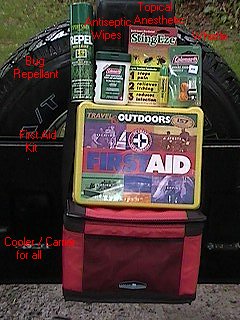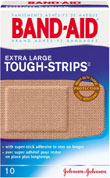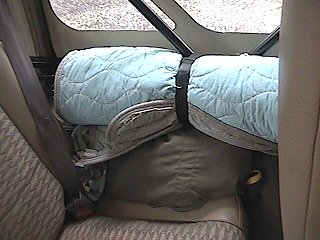First Aid | Additional Items | Blankets | Small Spare Parts | Sun Glasses | CPR and First Aid Training
Unfortunately, personal injury can come as a part of any activity that involves active outdoor sports and automobiles. With some caution, restraint, well maintained equipment, and plain luck, most outings can be enjoyed injury free. But when the unexpected happens, it is important to have something to deal with a variety of minor and major injuries. Sometimes, these provisions prevent disaster. The First Aid Kit shown has the following items:
|
First Aid | Additional Items | Blankets | Small Spare Parts | Sun Glasses | CPR and First Aid Training
| Additional Items | |
This picture shows some of the things that I carry in the trunk of the
Jeep. In addition to the First Aid kit that I described above, I have also added
some other things that I thought would be useful:
|
 |
         |
|
|
Here is everything stowed. The bottom of the First Aid kit can just be seen below the opening in the rear window. I left the items in their original packages since that provides an extra seal and in some cases the package contains additional instructions that are not printed on the containers. The carry case for the First Aid kit was purchased with the idea of having extra space so that more items could be added as they are located. The case is insulated to help keep the contents cool and dry. Red seemed an appropriate color... |
|
      
|
First Aid | Additional Items | Blankets | Small Spare Parts | Sun Glasses | CPR and First Aid Training
| Blankets | |
The blankets are rolled and tied with Velcro straps to the top struts, stored to each side of the rear seat. A 3/4 length French Army surplus overcoat is also peeking out from underneath the blanket. I have since stowed the blankets inside nylon stuff sacks that double as knapsacks.
|
 |
First Aid | Additional Items | Blankets | Small Spare Parts | Sun Glasses | CPR and First Aid Training
| Small Spare Parts, Flash Light, Binoculars | |
|
Not all emergencies involve human injury. Something as simple as a blown fuse can be a disaster if you don't have a spare. Take the time to look in your fuse boxes and see what fuses control critical systems on your vehicle. These days, modern vehicles are controlled by computers and other electronic devices. The failure of a single fuse can strand you. I bought a little plastic compartment case to sort the fuses, fuse tester, and fuse removal tool, and a few odd nuts, screws, etc., like my lug nut lock. And finding and troubleshooting can be tough if you don't have a good work light. While it is a good idea to have a large flash light, I like to carry a small one as well. Often it is easier to handle and store. Shown here for no particular reason other than they are stored in the console, is a pair of cheap binoculars that I keep in the Jeep so that I can watch the weather, spot the trail, and just in case...? I also carry tools and some supplies, like Threadlocker, and Radiator Stop Leak. These items are handy to keep around too.
|
First Aid | Additional Items | Blankets | Small Spare Parts | Sun Glasses | CPR and First Aid Training
Sun Glasses |
|
|
|
First Aid | Additional Items | Blankets | Small Spare Parts | Sun Glasses | CPR and First Aid Training
Training |
|
While it is important to have a well equipped First Aid kit, it is equally important to know what to do with the contents. Emergencies require clear thought, proper ordering of priorities, the ability to recognize symptoms of serious injury. Wilderness First Aid issues have additional implications that can be explored in training tailored to this special area. Check with the Wilderness Safety Council for courses leading to two-year certification. This page cannot possibly cover the spectrum of knowledge that an Emergency Medical Technician must know to be effective but remember these important points. In most situations it is important to get the bleeding, breathing and/or broken bones identified and under control before evaluating whether an injured person can be safely moved. In severe injuries it may not be safe to move a victim, so be sure to have blankets on hand to keep them warm and dry. Don't be lulled into complacency by shock. It can be just as deadly as the major injuries. Do not let even mildly injured victims start moving about until you can be certain that you know the extent of their injuries and whether or not they are going into, or in shock. If you anticipate that you will be more than a couple hours away from help, it is probably a good idea to take a first aid course and make sure you carry a comprehensive First Aid Kit. If you are responsible for a group, you'd better be aware of any special medical conditions in your party. If you are not capable of dealing with situations that could arise, be sure you bring someone with you who can. Sometimes, the injury is not significant but causes enough discomfort that it can ruin a nice day out. Minor injuries such as insect bites, scrapes, small cuts, scratches, headaches, bruises, slivers, and the like are much easier to deal with and overcome if supplies designed to address them are in your kit.
|
|
| Update 5/20/02 | CPR and First Aid Training |
|
|
First Aid | Additional Items | Blankets | Small Spare Parts | Sun Glasses | CPR and First Aid Training
Return to Jeep Specs Page
Shop for Jeep Toys and Books | See the Toy Jeeps | Off-Road Index
Photos, Layout and Design © 2001-2008 Paul M. Provencher All Rights Reserved.
Contents of this Web Site may not be used without written permission
Visitors since 5/21/01
Last Updated 02/09/2008 10:28:48 AM -0500